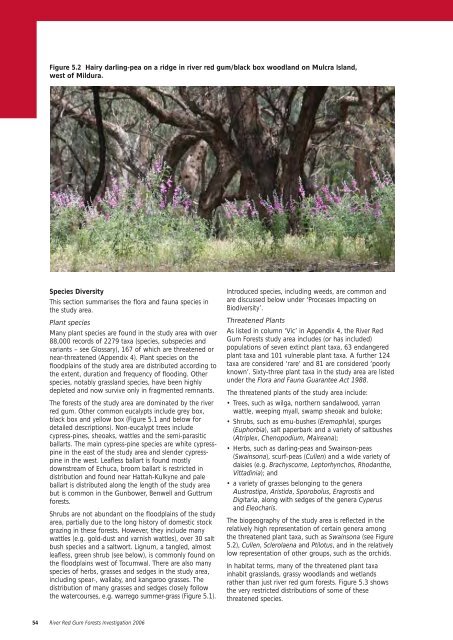Discussion Paper - Part A - Victorian Environmental Assessment ...
Discussion Paper - Part A - Victorian Environmental Assessment ...
Discussion Paper - Part A - Victorian Environmental Assessment ...
- No tags were found...
You also want an ePaper? Increase the reach of your titles
YUMPU automatically turns print PDFs into web optimized ePapers that Google loves.
Figure 5.2 Hairy darling-pea on a ridge in river red gum/black box woodland on Mulcra Island,west of Mildura.Species DiversityThis section summarises the flora and fauna species inthe study area.Plant speciesMany plant species are found in the study area with over88,000 records of 2279 taxa (species, subspecies andvariants – see Glossary), 167 of which are threatened ornear-threatened (Appendix 4). Plant species on thefloodplains of the study area are distributed according tothe extent, duration and frequency of flooding. Otherspecies, notably grassland species, have been highlydepleted and now survive only in fragmented remnants.The forests of the study area are dominated by the riverred gum. Other common eucalypts include grey box,black box and yellow box (Figure 5.1 and below fordetailed descriptions). Non-eucalypt trees includecypress-pines, sheoaks, wattles and the semi-parasiticballarts. The main cypress-pine species are white cypresspinein the east of the study area and slender cypresspinein the west. Leafless ballart is found mostlydownstream of Echuca, broom ballart is restricted indistribution and found near Hattah-Kulkyne and paleballart is distributed along the length of the study areabut is common in the Gunbower, Benwell and Guttrumforests.Shrubs are not abundant on the floodplains of the studyarea, partially due to the long history of domestic stockgrazing in these forests. However, they include manywattles (e.g. gold-dust and varnish wattles), over 30 saltbush species and a saltwort. Lignum, a tangled, almostleafless, green shrub (see below), is commonly found onthe floodplains west of Tocumwal. There are also manyspecies of herbs, grasses and sedges in the study area,including spear-, wallaby, and kangaroo grasses. Thedistribution of many grasses and sedges closely followthe watercourses, e.g. warrego summer-grass (Figure 5.1).Introduced species, including weeds, are common andare discussed below under ‘Processes Impacting onBiodiversity’.Threatened PlantsAs listed in column ‘Vic’ in Appendix 4, the River RedGum Forests study area includes (or has included)populations of seven extinct plant taxa, 63 endangeredplant taxa and 101 vulnerable plant taxa. A further 124taxa are considered ‘rare’ and 81 are considered ‘poorlyknown’. Sixty-three plant taxa in the study area are listedunder the Flora and Fauna Guarantee Act 1988.The threatened plants of the study area include:• Trees, such as wilga, northern sandalwood, yarranwattle, weeping myall, swamp sheoak and buloke;• Shrubs, such as emu-bushes (Eremophila), spurges(Euphorbia), salt paperbark and a variety of saltbushes(Atriplex, Chenopodium, Maireana);• Herbs, such as darling-peas and Swainson-peas(Swainsona), scurf-peas (Cullen) and a wide variety ofdaisies (e.g. Brachyscome, Leptorhynchos, Rhodanthe,Vittadinia); and• a variety of grasses belonging to the generaAustrostipa, Aristida, Sporobolus, Eragrostis andDigitaria, along with sedges of the genera Cyperusand Eleocharis.The biogeography of the study area is reflected in therelatively high representation of certain genera amongthe threatened plant taxa, such as Swainsona (see Figure5.2), Cullen, Sclerolaena and Ptilotus, and in the relativelylow representation of other groups, such as the orchids.In habitat terms, many of the threatened plant taxainhabit grasslands, grassy woodlands and wetlandsrather than just river red gum forests. Figure 5.3 showsthe very restricted distributions of some of thesethreatened species.54 River Red Gum Forests Investigation 2006
















